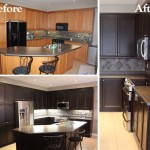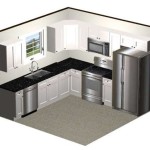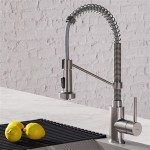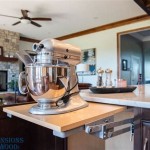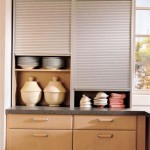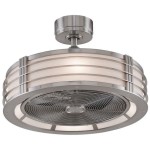Ideas for Refacing Kitchen Cabinets: A Comprehensive Guide
Kitchen cabinets often constitute a significant portion of a kitchen's overall aesthetic and functionality. Over time, cabinets can become worn, outdated, or simply no longer align with evolving design preferences. A full kitchen remodel can be a costly and disruptive undertaking. Refacing kitchen cabinets offers a viable alternative, allowing homeowners to significantly update the appearance of their kitchens without the extensive demolition and expense associated with a complete replacement.
Refacing involves replacing the existing cabinet doors, drawer fronts, and sometimes the external hardware, while preserving the existing cabinet boxes. This approach provides a cost-effective and environmentally conscious method of revitalizing a kitchen. It minimizes waste by repurposing the core structure of the cabinets and reduces the amount of time and labor required compared to a full replacement.
Choosing the right refacing approach and materials is crucial for achieving the desired outcome. Multiple options exist, each with its own set of advantages and considerations in terms of cost, durability, and aesthetic appeal. A thorough understanding of these options is essential for making informed decisions that align with budgetary constraints and design goals.
Understanding the Scope of Refacing: Determining What Can Be Refaced
Before delving into specific design ideas, it is important to assess the condition of the existing cabinet boxes. Refacing is only advisable if the cabinet boxes are structurally sound. Check for any signs of warping, water damage, or significant damage to the box material. If the cabinet boxes are in poor condition, replacement might be a more prudent long-term investment.
The scope of refacing can also be tailored to specific needs and preferences. Some homeowners may choose to only replace the doors and drawer fronts, keeping the existing hardware and side panels. Others may opt for a more comprehensive refacing, including new doors, drawer fronts, hardware, and veneer or laminate applied to the exposed cabinet box surfaces.
Consider also the layout and functionality of the existing cabinets. Refacing presents an opportunity to make minor modifications, such as adding pull-out shelves or soft-close hinges. These enhancements can improve the usability and convenience of the kitchen without requiring a complete overhaul.
Material Options for Refacing: Balancing Aesthetics, Durability, and Cost
The choice of materials for refacing is a key factor in determining the final look and feel of the kitchen. Several materials are commonly used for refacing, each offering a distinctive combination of aesthetics, durability, and cost.
Wood Veneer: Wood veneer consists of thin sheets of real wood applied to a substrate. This option offers the natural beauty and warmth of wood at a lower cost than solid wood. Veneer can be stained or painted to achieve a wide range of finishes. However, veneer is more susceptible to scratches and dents than solid wood and requires careful maintenance.
Rigid Thermofoil (RTF): RTF is a vinyl material that is heat-fused to a substrate, typically medium-density fiberboard (MDF). RTF is a cost-effective and durable option that is resistant to moisture and staining. It is available in a wide range of colors and textures, including wood-grain patterns. However, RTF can be susceptible to peeling or bubbling in high-heat areas, such as near the stove or oven.
Laminate: Laminate is a synthetic material made from layers of paper and resin. It is a durable and cost-effective option that is resistant to scratches, stains, and moisture. Laminate is available in a wide range of colors, patterns, and textures, including wood-grain patterns. However, laminate can have a less realistic appearance than wood veneer or solid wood.
Solid Wood: This option involves replacing the doors and drawer fronts with solid wood. While being the most expensive option, it provides the highest quality and most durable solution. Solid wood can be stained, painted, or left natural to showcase its unique grain patterns. It is also the most repairable option, as scratches and dents can be sanded and refinished. Common wood choices include maple, oak, cherry, and walnut, each offering its own distinct aesthetic characteristics.
The selection of material should be based on a careful evaluation of budget, desired aesthetic, and anticipated usage. High-traffic kitchens may benefit from the durability of laminate or RTF, while those seeking a more luxurious look may opt for wood veneer or solid wood.
Design Ideas for Refaced Kitchen Cabinets: Transforming Your Kitchen's Aesthetic
Refacing provides a multitude of opportunities to transform the kitchen's aesthetic and reflect personal style preferences. Choosing the right door styles, finishes, and hardware can significantly alter the overall appearance of the space.
Door Styles: Shaker-style doors are a classic and versatile choice that complements a wide range of kitchen styles, from traditional to contemporary. They feature a recessed center panel and clean, simple lines. Raised-panel doors offer a more traditional and ornate look, with a raised center panel and decorative detailing. Slab doors are a modern and minimalist choice, featuring a flat, smooth surface. Glass-front doors can add visual interest and allow for the display of decorative items. Consider the overall style of the kitchen and personal preferences when selecting a door style.
Finishes: Paint provides virtually limitless color options, allowing for complete customization of the kitchen's color scheme. Consider current trends, such as neutral gray tones or bold pops of color. Stain enhances the natural beauty of the wood grain, adding warmth and character to the kitchen. Choose a stain color that complements the existing flooring and countertops. Glaze adds depth and dimension to painted or stained cabinets, creating a more weathered or antique look.
Hardware: Cabinet hardware, such as knobs and pulls, can significantly impact the overall look and feel of the kitchen. Choose hardware that complements the door style and finish. For example, sleek and modern hardware pairs well with slab doors, while more ornate hardware complements raised-panel doors. Consider the finish of the hardware as well – brushed nickel, stainless steel, and oil-rubbed bronze are popular choices. The size and placement of the hardware can also affect the overall appearance of the cabinets.
Color Coordination: Carefully consider the color palette of the entire kitchen when refacing the cabinets. The cabinets should complement the countertops, backsplash, flooring, and appliances. Use color swatches and samples to visualize the final result. Consider using a color wheel to create a harmonious and balanced color scheme.
Two-Tone Cabinets: Consider opting for a two-tone cabinet design, where upper and lower cabinets are different colors. This is a popular trend that can add visual interest and depth to the kitchen. For example, you could choose light-colored upper cabinets to create a more open and airy feel, while using darker-colored lower cabinets to ground the space.
Practical Considerations: Budgeting and Installation
Before embarking on a refacing project, it is crucial to establish a realistic budget. The cost of refacing can vary depending on the materials used, the size of the kitchen, and whether the installation is done DIY or professionally.
Obtain quotes from multiple contractors to compare prices and services. Be sure to ask for a detailed breakdown of the costs, including materials, labor, and any additional fees. Factor in potential unforeseen expenses, such as unexpected repairs to the cabinet boxes.
Consider whether to hire a professional installer or tackle the project as a DIY endeavor. Professional installation can ensure proper fit and finish, but it will also add to the overall cost. DIY refacing can save money, but it requires a significant investment of time and effort, as well as some carpentry skills.
Plan the project carefully, taking into account the time required for ordering materials, preparing the cabinet boxes, and installing the new doors and drawer fronts. Be prepared for some disruption during the refacing process, as the kitchen will be temporarily out of commission.
Proper preparation of the existing cabinet boxes is crucial for a successful refacing project. Clean the cabinet boxes thoroughly to remove any grease, dirt, or grime. Sand the surfaces to create a smooth and even base for the new veneer or laminate. Repair any damaged areas before applying the new materials.
Accurate measurements are essential for ensuring a proper fit of the new doors and drawer fronts. Measure each cabinet opening carefully and double-check the measurements before ordering the materials. Use shims and spacers as needed to ensure that the doors and drawer fronts are aligned and level.
Choosing the right adhesive and fasteners is important for ensuring a secure and long-lasting bond. Use high-quality construction adhesive to attach the veneer or laminate to the cabinet boxes. Use screws or nails to secure the doors and drawer fronts to the cabinet boxes.
Pay attention to the details. Consider the finishing touches, such as adding decorative molding or trim. These details can enhance the overall look of the refaced cabinets and create a more polished and professional appearance.
By considering all the ideas, practical considerations along with the scope of refacing, homeowners can make informed decisions to create a revitalized kitchen space.

20 Kitchen Cabinet Refacing Ideas Options To Refinish Cabinets Remodel Small Design Backsplash Designs

New Cabinet Refacing Ideas To Revamp Your Old Kitchen Layout

Kitchen Cabinet Refacing Options And Tips Hgtv

Cabinet Refacing Ideas Diy Projects Craft How To S For Home Decor With Videos

Painted Furniture Ideas Diy Refacing Kitchen Cabinets

6 Kitchen Makeovers That Benefited From Refaced Cabinets

Cabinet Refacing Ideas Diy Projects Craft How To S For Home Decor With Videos Kitchen Remodel Small Remodeling Cabinets

Kitchen Refacing Ideas The Home

Kitchen Cabinet Refacing How To Redo Cabinets

8 Kitchen Cabinet Refacing Before And After Projects


